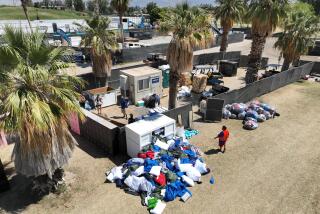To South African Villagers, a Treasure Can Be 5 by 7
- Share via
In the framed photograph, a woman with a beehive hairdo and sea-foam green dress wraps her fleshy arms around a smiling toddler.
“That’s my mom and me,” said Laura Adams, pointing to the 5-by-7 photo on display in her Costa Mesa living room. “She died when I was 10. That’s the only photo I have of her. It’s meant so much to me.”
The power of that single image gave the 37-year-old an idea during a church mission last year to an AIDS-ravaged squatters camp in South Africa.
“The parents have no kind of legacy to give,” said Adams, a full-time piano teacher and part-time photographer.
“With a photo, they have something to pass on to their children.”
Over the last 14 months, Adams said she has handed out more than 500 photos she had taken of families in Kayamandi, a settlement that’s about a 45-minute drive from Cape Town.
Adams’ brainchild -- called the Photo Legacy Project -- has been adopted by fellow missionaries at Mariners Church in Irvine.
For example, six volunteer photographers took part in a July trip to South Africa. They passed out an additional 500 pictures.
“We brought toys, soccer balls and candy, but it was the photos that everyone got so excited over,” said Steve Wolford, a church volunteer who lived in Africa for 15 years. “The beauty of Laura’s vision is that the kids will have a remembrance of their parents who are getting wiped out by AIDS.
“If you don’t have a photo, how are you going to remember?”
Adams and others said they plan to spread the word about the project’s success at churches and Christian groups, showing others a simple and meaningful way to connect with the world’s impoverished people.
“Most of the people we gave photos to in South Africa have never had a white person in their home,” Adams said. “It’s significant in itself that they would allow us to come in and pray for them.”
Church volunteers said they eventually want to equip the villagers in South Africa and elsewhere with digital cameras and printers so they can begin small photography businesses or simply give away family portraits.
And Adams has set up www.thingslovelyandpure.com, which explains how to duplicate the project, along with a gallery of photos.
Mariners Church regularly organizes missionary trips to Kayamandi, a cramped one-square-mile camp of about 30,000.
Volunteer doctors and nurses work to improve HIV/AIDS prevention and treatment programs. Others comfort both HIV/AIDS patients and counselors, befriend children, including many orphans, and proselytize.
Adams’ original volunteer job in July 2004 was simply to document in photographs a mission to South Africa.
But she found herself shooting family portraits with her digital camera, traveling to a nearby city to get them printed, then handing them out to the villagers.
“I felt like they were giving me an image to take back to the United States and tell their story, and I would have that image forever,” Adams said. “But they wouldn’t have a copy of it. It was very important for me to get them a photo too.”
She said she was surprised at the “pure joy” expressed by the South Africans when they were handed their photo.
“They’d just yell, turn around and run and show their friends,” Adams said.
Reactions like those helped Adams realize that her photography skills were not a trivial part of the mission, as she first thought.
“This is exactly what I’m supposed to be doing with my talents,” she said.
Adams said she scraped together enough money -- about $3,500 -- from supporters to finance another trip to Kayamandi last November and plans to return next month.
And her story has inspired others, such as Katie Taylor, 25, who traveled to South Africa with a team from Mariners in July, camera in hand.
“I love taking pictures and appreciate the power of film,” said the Los Angeles resident, a casting assistant in the movie industry.
Taylor said she’ll never forget the reaction of one frail woman in her late 60s at the squatters camp as she was given her picture.
“She clutched her photo and just beamed as she showed it to others,” Taylor said. “She couldn’t believe it.
“She told us, ‘You blessed us. So many white people come and go here, but you really see us.’ ”
More to Read
Sign up for Essential California
The most important California stories and recommendations in your inbox every morning.
You may occasionally receive promotional content from the Los Angeles Times.










